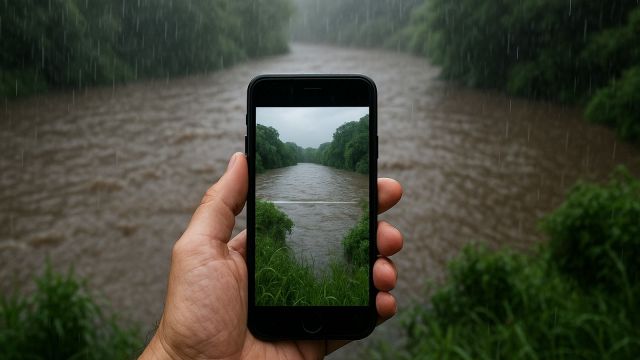Click here to join Express Pune WhatsApp channel and get a curated list of our stories
As rain pounds Pune, environment-conscious residents map water levels of rivers with a simple device: phone
Citizens participating in the programme are given simple tips, such as to hold a phone straight.
 Volunteers go to a certain spot along the river and take photos and videos of the water body. Then upload it on EpiCollect5. (Created using Dall-E)
Volunteers go to a certain spot along the river and take photos and videos of the water body. Then upload it on EpiCollect5. (Created using Dall-E)As the rain pelted down, retired engineer Prashant Shevgaonkar walked along the river at Pimple Nilakh and adjoining stretches taking photos of waterlogged or flooded areas. He is among the 10-15 environment-conscious Pune citizens, who are engaged in a crowd-hydrology initiative to map the levels of the rivers and other waterbodies during the rain. Their focus is the Mula-Mutha at present, with volunteers spread across sites, such as Ambedkar bridge, Harris bridge and Bund Garden bridge.
“We use an app, EpiCollect5, to upload the photos and other data. These records are, then, studied against specific measurements to understand the relationship between rain, water levels and the capacity of rivers of Pune,” says Shevgaonkar.
“EpiCollect5 is a citizen science tool developed at Oxford University. It is globally available and free to download on iOS and Android. We are asking volunteers to upload photos on the app. In Pune, we have a small window of heavy rains and flooding. On August 19 and 20, we had the first such episode of incessant rain after launching the initiative,” says Shevgaonkar.
Volunteers are instructed to go to a certain spot along the river and take photos and videos of the water body. “Volunteers are not asked to measure the water levels. This work is done in the backend and based on previously conducted measurements. If there is a ghat, we use the number of steps that the water has reached during a particular spell of rain. At other times, we use the pixels of the photos to calculate the level of water,” says Shevgaonkar.
“Our long-term plan is to conduct various river-related studies through citizen science, with the aim of encouraging citizens to become true friends of the rivers,” says Prajakta Mahajan, a citizen associated with Pune River Revival. “That is why we are calling the initiative Nadimitra. Although it begins in Pune, we envision Nadimitra reaching out to all citizens living along any river. We are beginning with monitoring river water levels, and this first activity is called Nadimitra Water Level,” she adds.
Citizens participating in the programme are given simple tips, such as to hold a phone straight. “If a phone is held at an incline, then there is a chance of perspective distortion,” says Shevgaonkar. In June, he conducted a webinar on “Crowd Hydrology for Rivers” for the Pune River Revival. A recording is available on YouTube.
At present, the project is concentrating on three stretches: Mula, Mutha and Mula-Mutha after their confluence. Even during the recent episodes of high rains, the water discharges were moderate, nowhere near the blue or red lines. “Still, this gives us a chance to get data with reasonably high water levels which we can analyse to understand how the river behaves. Since we started the project in July, we are still at a nascent stage,” he says.
Apart from providing citizen data from across Pune, the project will help draw attention to serious issues, such as the levee effect. Also called “Safe Development Paradox”, this describes a phenomenon where flood protection measures such as embankments actually increase flood risk, by enabling development in low-lying areas which are now perceived safe. Sangamwadi and other low lying areas of Pune are densely populated and vulnerable to this effect,” he says.
Click here to join Express Pune WhatsApp channel and get a curated list of our stories








